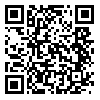1. Nabavi S, Sohrabi F, Afrouz G, Delavar A, Hosseinian S. Predicting the mental health of teachers based on the variables of self-efficacy andsocial support . Iran J Health Educ Health Promot. 2017;5(2):129–38. [Persian] [
Article]
2. Aldrup K, Klusmann U, Lüdtke O. Does basic need satisfaction mediate the link between stress exposure and well-being? a diary study among beginning teachers. Learn Instr. 2017;50:21–30. [
DOI]
3. Sadati Firoozabadi S, Norani Kotenaei Z. Career resiliency of teachers of special schools based on coping styles and the mediating role of religious beliefs. Journal of Exceptional Children. 2018;18(1):97–108. [Persian] [
Article]
4. Burić I, Penezić Z, Sorić I. Regulating emotions in the teacher’s workplace: development and initial validation of the Teacher Emotion-Regulation Scale. Int J Stress Manag. 2017;24(3):217–46. [
DOI]
5. Andela M, Truchot D, Van der Doef M. Job stressors and burnout in hospitals: the mediating role of emotional dissonance. Int J Stress Manag. 2016;23(3):298–317. [
DOI]
6. Salmela-Aro K, Tynkkynen L. Gendered pathways in school burnout among adolescents. J Adolesc. 2012;35(4):929–39. [
DOI]
7. Parker PD, Salmela-Aro K. Developmental processes in school burnout: a comparison of major developmental models. Learn Individ Differ. 2011;21(2):244–8. [
DOI]
8. Beghetto RA, Corazza GE. Dynamic perspectives on creativity; new directions for theory, research, and practice in education. Cham: Springer International Publishing; 2019. [
DOI]
9. Choudhary AI, Saifullah N, Alam M, Wasif Zafar M, Humayon A. Job satisfaction: a contest between human and organizational behavior. International Journal of Economics and Research. 2015;6:45–51.
10. Fekri K, Shafeeabadi A, Norani Pour R, Ahghar Gh. Comparing the effectiveness of two approaches of vocational counseling on the components of entrepreneurial behavior. Journal of New Approaches in Educational Administration. 2014;4(13):19–32. [Persian] [
Article]
11. Mard SM, Zinabady HR, Arasteh HR. Indexes of a successful educational leader; findings of a phenomenological study. Journal of School Administration. 2017;5(2):109–28. [Persian] [
Article]
12. Hill F, Huq R. Employee empowerment: conceptualizations, aims and outcomes. Total Quality Management & Business Excellence. 2004;15(8):1025–41. [
DOI]
13. Sorati P. The mediating role of perceived stress in the relationship between social problem solving styles and quality of work life among the teachers. J Res Behav Sci. 2018;15(4):427–34. [Persian] [
Article]
14. Krieshok TS, Black MD, McKay RA. Career decision making: the limits of rationality and the abundance of non-conscious processes. J Vocat Behav. 2009;75(3):275–90. [
DOI]
15. Houtzagers G. Empowerment, using skills and competence management. Part and Emp: An Int Jnl. 1999;7(2):27–32. [
DOI]
16. Lewis RL, Brown DA, Sutton NC. Control and empowerment as an organising paradox: implications for management control systems. Accounting, Auditing & Accountability Journal. 2019;32(2):483–507. [
DOI]
17. Nasiri F, Gholtash A, Sarchahani Z. The relationship between employee empowerment and job performance and productivity of manpower in the department of education of fars provincein. Journal of Managing Education in Organizations. 2016;4(2):63–90. [Persian] [
Article]
18. Hassanpour A, Abbasi T, Norouzi M. The survey on the role of transformational leadership in employee empowerment. Management Research in Iran. 2011;15(1):159–80. [Persian] [
Article]
19. Shafiabadi A. Rahnamaee va moshavereye shoghli va nazariye haye entekhabe shoghl (ba tajdid nazar kolli va ezafat) [Career guidance and advice and job selection theories (with general revision and additions). Tehran: Roshd Pub; 2019. [Persian]
20. Mirzayee F, Fekri K. The Effectiveness combination Shafiabady’s multiaxial pattern with Krumboltz’s social learning theory on vocational gratification in female teachers. Journal of New Approaches in Educational Administration. 2018;9(33):153–72. [Persian] [
Article]
21. Zhao JL, Li XH, Shields J. Managing job burnout: the effects of emotion-regulation ability, emotional labor, and positive and negative affect at work. Int J Stress Manag. 2019;26(3):315–20. [
DOI]
22. Tian X, Liu C, Zou G, Li G, Kong L, Li P. Positive resources for combating job burnout among Chinese telephone operators: resilience and psychological empowerment. Psychiatry Res. 2015;228(3):411–5. [
DOI]
23. Delavar A. Mabani nazari va amali pazhouhesh dar oloume ensani va ejtemaee [Theoretical and practical foundations of research in humanities and social sciences]. Tehran: Roshd Pub; 2019. [Persian]
24. Maslach C, Jackson SE. The measurement of experienced burnout. J Organiz Behav. 1981;2(2):99–113. https://doi.org/10.1002/job.4030020205
25. Akbari R, Ghafar Samar R, Kiany GR, Eghtesadi AR. Factorial validity and psychometric properties of Maslach Burnout Inventory –the Persian version. Knowledge and Health. 2011;6(3):1–8. [Persian] [
DOI]
26. Rezaei Aderyani R, Shabani A, Abedi MR. A study of burnt-out syndrome of librarians in the university of Isfahan university and its relationship with their demographic characteristics. Journal of Information Systems and Services. 2013;2(4):11–20. [Persian] [
Article]





